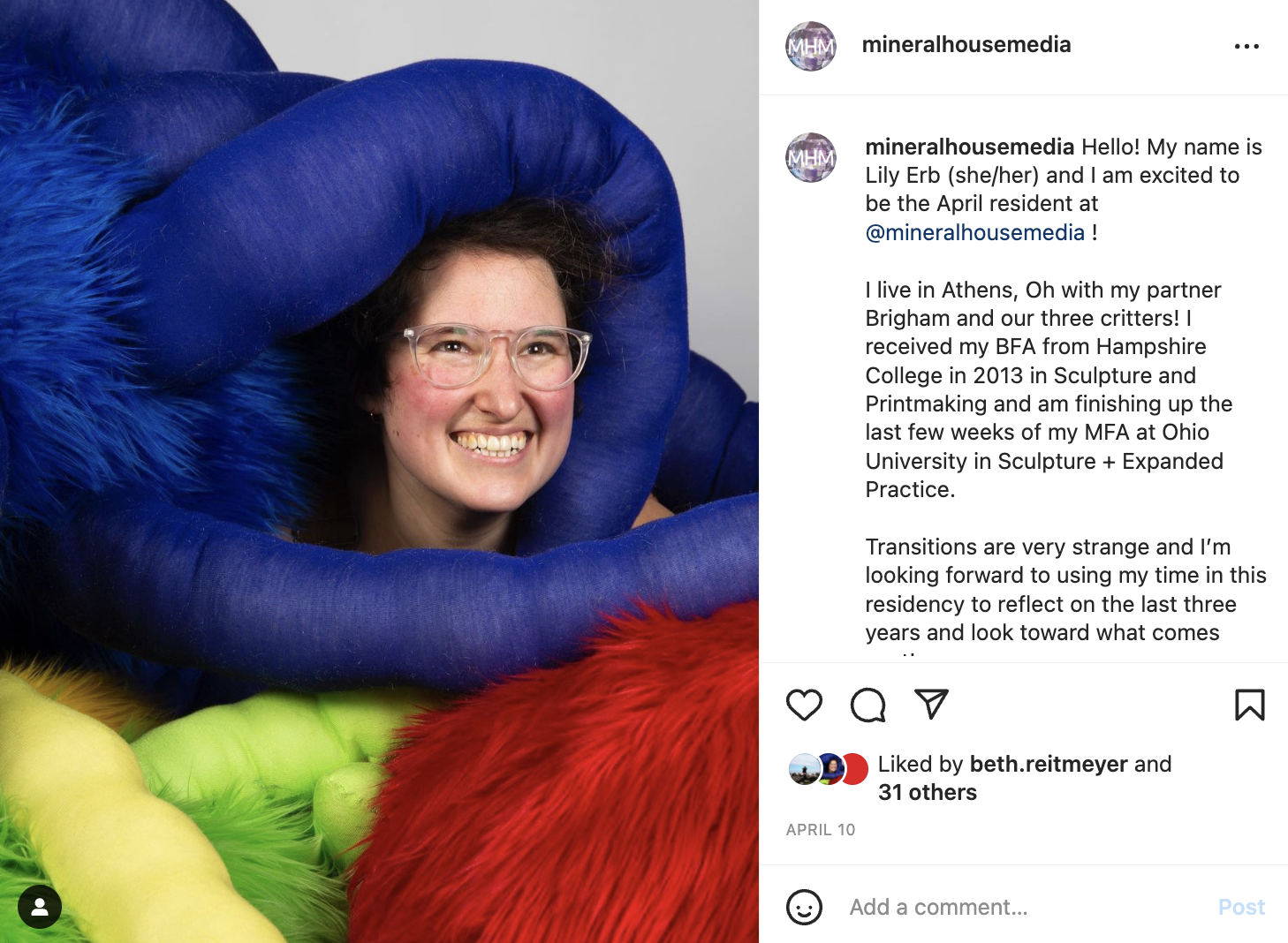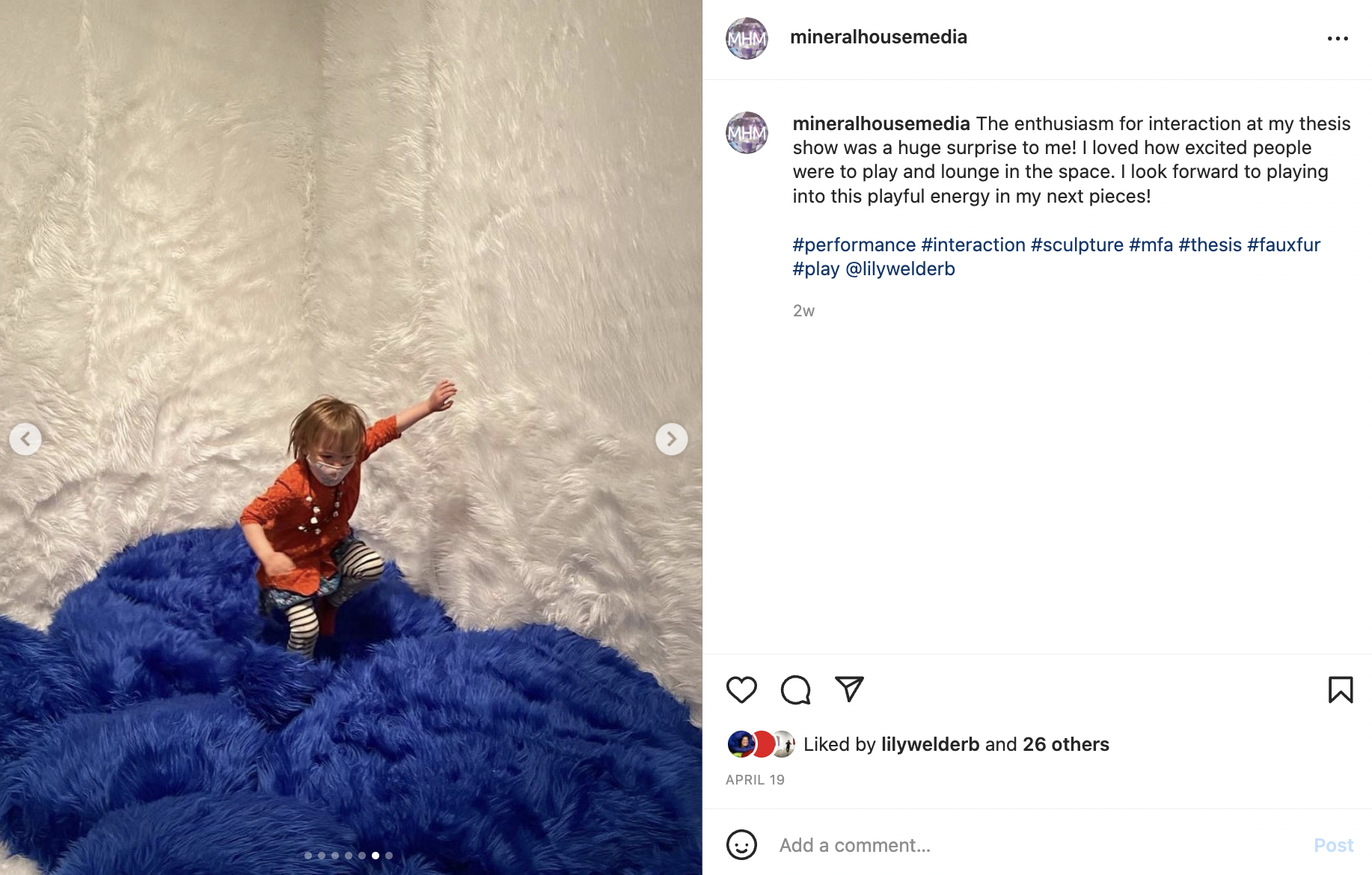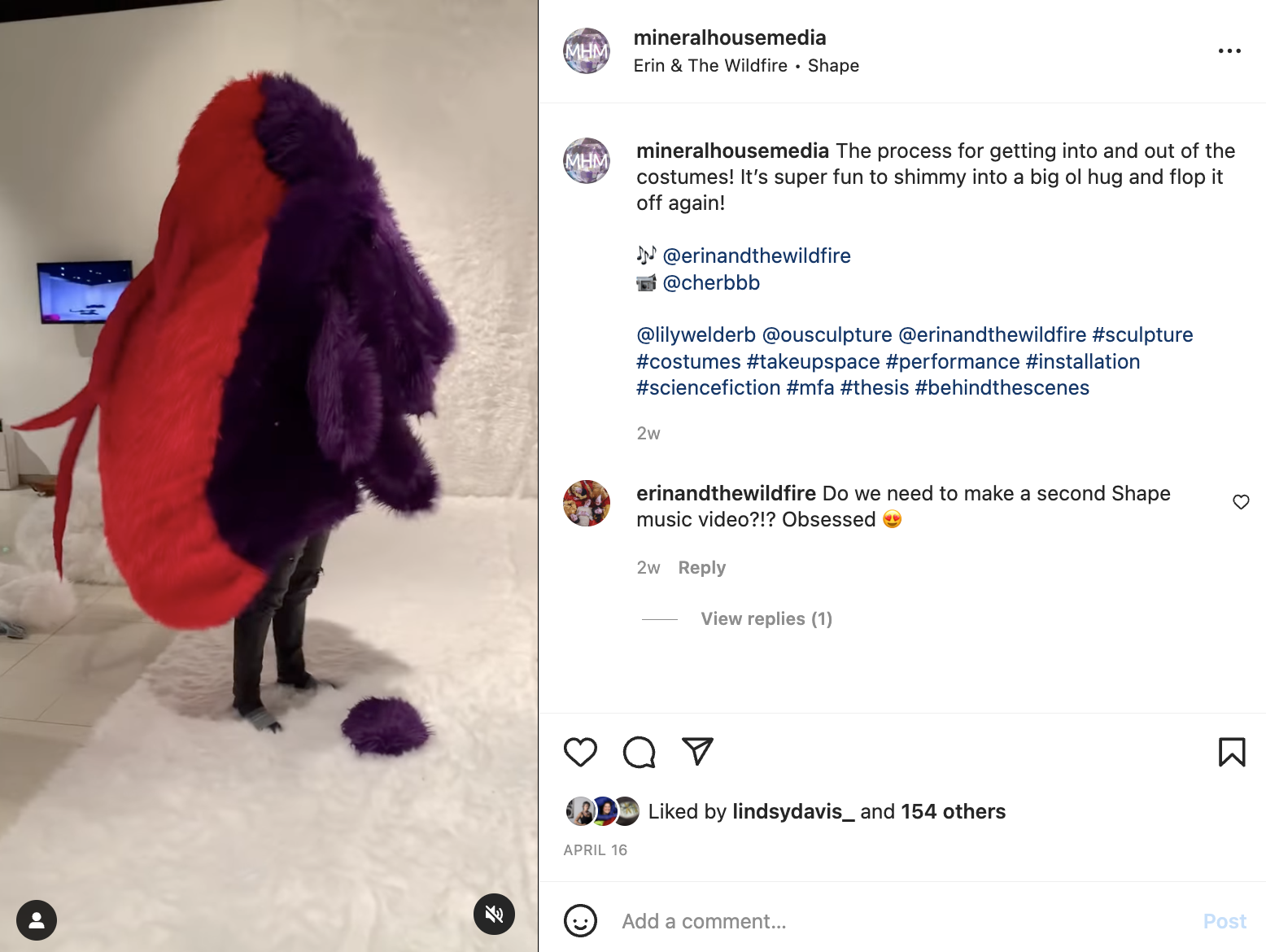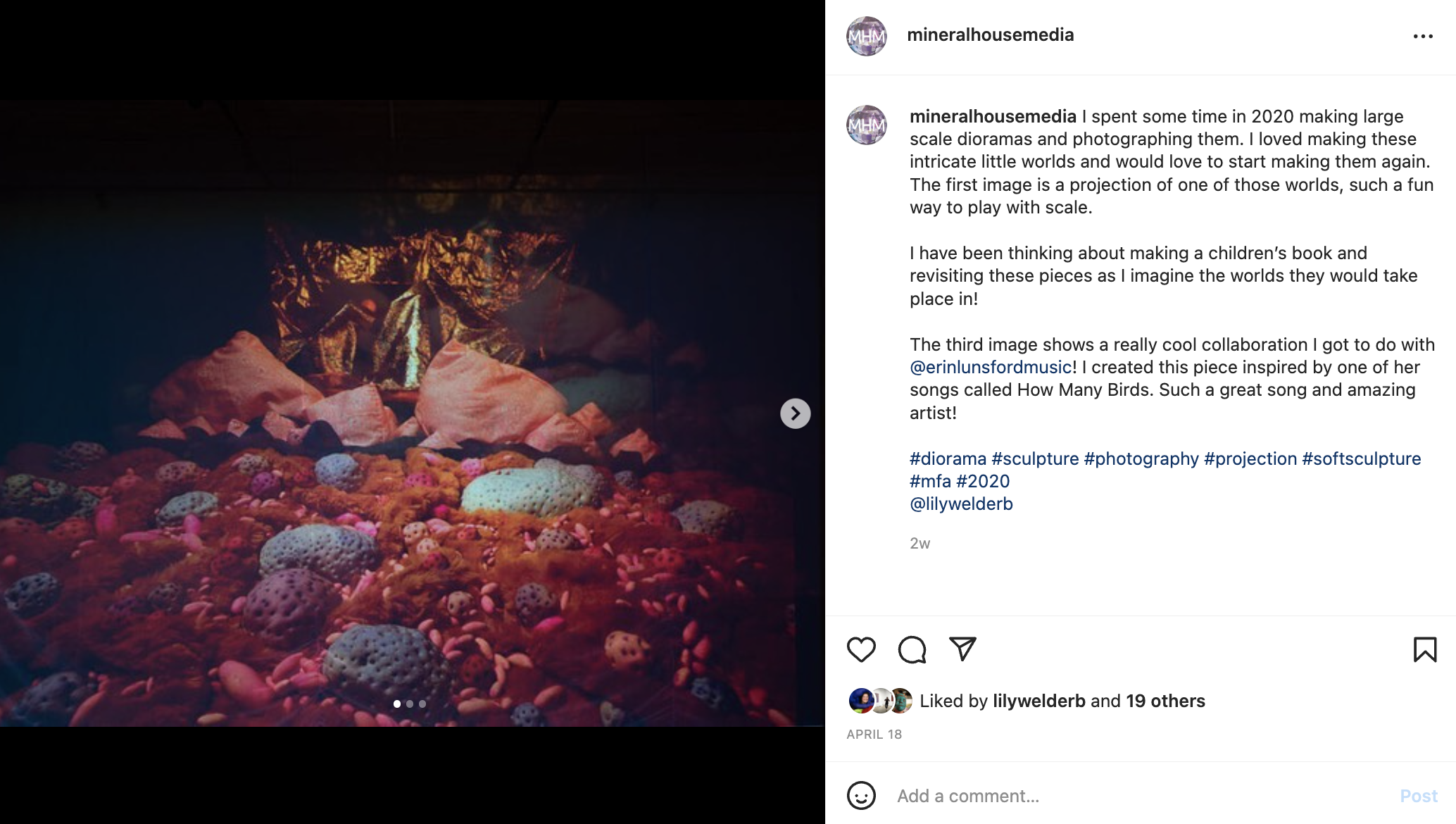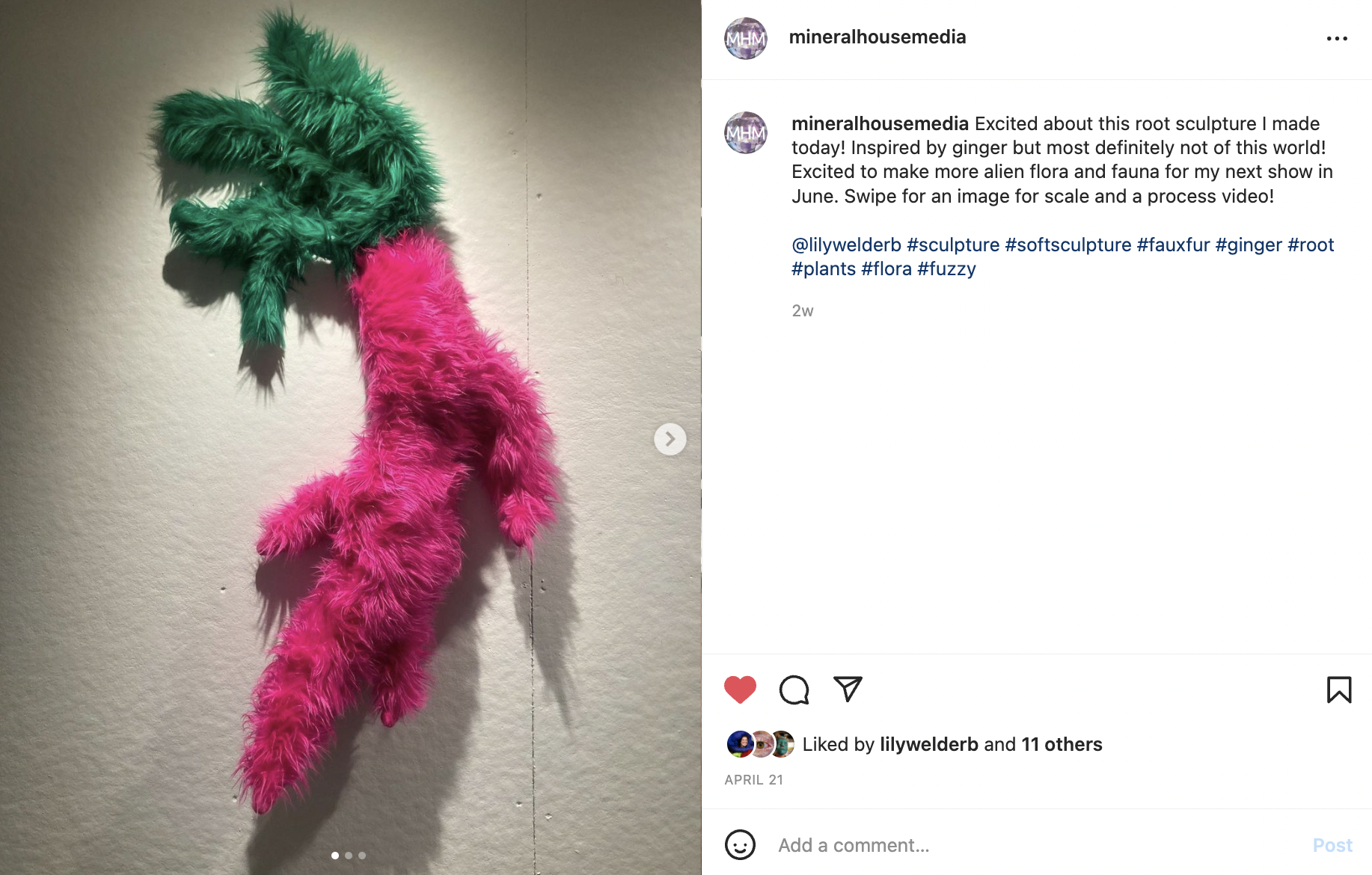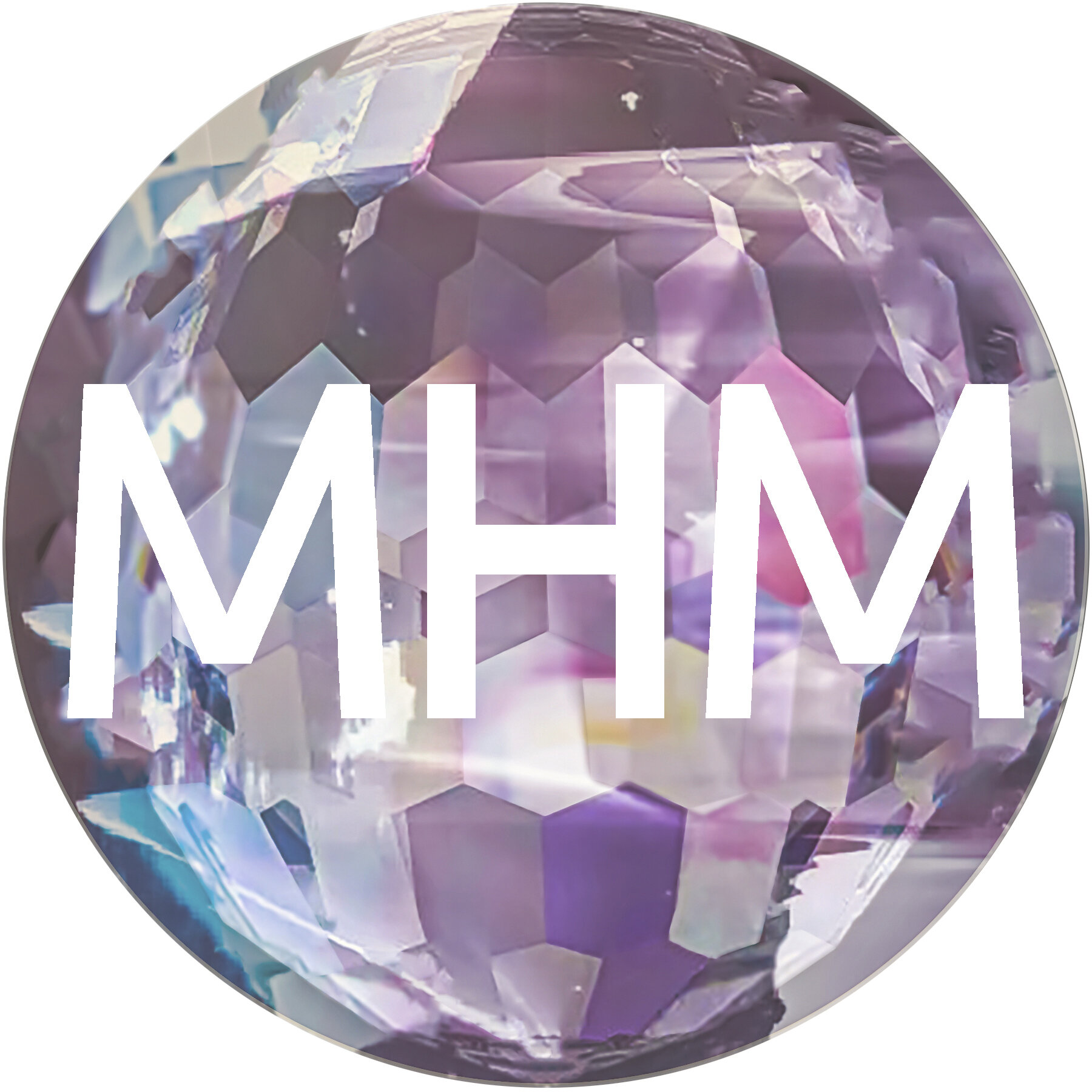Interview with Lily Erb
Interview with
Lily Erb
April 2022 Digital Resident
A conversation with Clay, Olivia, and Larkin of Mineral House Media
“As I explore community dynamics in a time of societal reimaging, I am interested in points of friction in unequal power relationships. Through a Science Fiction lens, I ask questions- how do individuals react to confrontation and friction in the interdependent relationships necessary for building communities? When does conflict arise and can that conflict become generative? When food transportation and other systems become halted or delayed and people depend on each other acutely for basic survival how do we put interdependence into practice?
Science fiction allows a defamiliarization of known scenarios and social systems. To create a comfortable defamiliarization I reference Sesame Street, a place that many young people learn from creatures that resemble stuffed animals- an important tool in early development of self-soothing techniques. My work brings together serious exploration of societal roles and seemingly child appeasing aesthetics.
The process of creating these performance pieces deals with interdependence in practice as much as the final product does metaphorically. These performances are reliant on at least one other person’s participation thus creating a relationship of interdependence between myself and the other. For this reason, the pieces are not considered theatrical productions as the pageantry and ego that often surrounds theatre is not conducive to the exploration of interdependence.”
-Lily Erb
MHM: What is your relationship to your costumes? Do you personify them and view them as children or companions, or view them as creatures with their own personalities?
LE: I think for me the line is somewhere between companions and creatures with their own personalities. As I’m making each costume I try it on periodically to see what it’s looking like and test it out. As I go through that process each piece definitely develops its own personality. I did write up astrological charts for each of the creatures while I was solidifying my scenes!
MHM: After initial sketches, how do you proceed in planning out and creating your costumes? Do you make a pattern or just start cutting and sewing material?
LE: I came to sewing sort of a backwards way so I don’t use patterns! I sketch out a general form on the fabric and start cutting! I adjust as I go and luckily faux fur is pretty forgiving so adjustments are possible if I make mistakes! When I’m adding additional objects to the costumes, it's a process of trial and error. I design the general form that will be repeated on the costume and then play around with how unique I can get each one to look while staying within the theme.
MHM: With your work involving touch, performance, and collaboration, how did the pandemic affect your practice and what adjustments did you have to make?
LE: Funnily enough my work wasn’t this tactile before the pandemic. I think the creation of costumes and things that I could snuggle became much more important as the pandemic wore on and spending time around friends was more difficult. I was certainly starting to go in this direction but I think that my work might not be where it is now if I hadn’t had the opportunity to film performances to show to people before beginning to do them live. It allowed me to test the boundaries of my vulnerability. I also enjoy making these spaces really large so that people can wander around inside of them and experience them while still staying a safe distance from each other. And the costumes are like a giant mask and the performers are wearing masks inside of them, it’s honestly probably safer than a lot of scenarios!
MHM: How do you approach your studio? Do you have a system for balancing admin and physically creating?
LE: I like to think I have a really excellent system worked out but the truth is I wait for the days when I feel excited about doing the administrative stuff or when a deadline is looming. The making is the thing I’m the most excited about and when I get in a groove it just becomes second nature to go to the studio.I love taking something I've sketched out or imagined and making it a real life object. I especially love when I have the time to make something in one sitting, of course this is not possible with the big works! It is hard for me to think of the studio as a place of casual making at this moment, I’m interested in re-discovering a less academic approach to the studio. I love developing the concept of a work but at this moment it feels really freeing to make something just because I like how it looks and feels.
MHM: Do you ever feel pressure to justify making work that can be perceived as playful or childlike?
LE: I have certainly felt that pressure, especially while in grad school. After a lot of back-and-forth I decided that I am OK with it looking childlike because I think children understand intrinsically a lot of things that we as adults spend a lot of time trying to re-learn. I enjoy talking to children about my work more than I enjoy talking to adults a lot of the time! They see things in such a pure and wonderful form. At my thesis show there were a bunch of children sitting in the front row and they were narrating and the stories they were telling in the information they were picking up on was really fun to hear.
MHM: Can you talk more about your transition from working in steel to making your costumes and performance? How is your process with these materials similar/different?
LE: It is a very bizarre transition! I started working with soft sculpture when I was a resident artist at Anderson Ranch in 2018 and a co-resident lent me her sewing machine. I think it’s similar in that both materials come in the set linear forms and then I like to see the ways that I can twist them into something totally bizarre and unusual. The pacing of working with fabric is slower and quieter which is nice. Both processes are hard on my body in different ways! The performance aspect is sometimes difficult for me because I am still figuring out what it looks like when a performance piece is finished. With an installation or a costume I can tell when I have done enough work and put in enough effort to learn something from it. It has gotten slightly easier since I began doing performances in the fall of 2020! As a side note it is a million times easier to transport the soft sculpture. It is way lighter and can be compressed and in that way I don’t miss working with metal at all!
MHM: Could you describe what makes something alien/bizarre to you?
LE: My main inspiration for bizarre/alien is ocean creatures, fungi, and insects. So many science-fiction films and novels create aliens out of parts of creatures that already exist on this planet. I think it’s really fascinating that the ocean is such a bizarre and strange place within this world that all of us struggle to understand. I love watching nature documentaries when I’m in the studio and learning about the way creatures move and the purposes of their unusual forms. Fungus is also a huge inspiration because it’s so weird and perfect and mushrooms speak to large scale connection which is a lot of what my work is interested in. Nature is really so weird and I love it, everything can exist and thrive in its own niche.
MHM: How long does it take to make one of your large-scale dioramas, and what does the process look like? How do you know when to stop?
Close up of installation by Lily Erb
LE: The large scale dioramas are really fun, they're about 2’x3’x4’. I’m super excited to start making them again. I usually take about a week to make them. Because they’re photographed with an emphasis on the foreground the background ends up being cobbled together in ways that you wouldn’t be able to see in the photograph. So I spend a lot of time crafting, often using model magic clay, objects that sit in the foreground that look like fungus or sea creatures or seed pods and then sort of develop a foothill background and then far distant mountainous background. I like thinking of creating a sky that one would imagine seeing on a foreign planet behind that mountain. I put in layers of see-through fabric between each ecosystem to create an atmosphere. I try to stop when it starts to get too busy. I’m definitely a person who loves the maximalist aesthetic as you can probably tell so I try to make it to the point right before it becomes overwhelming.
MHM: Hey what’s your favorite color?
LE: I love purple! And anything gold shimmery shiny. The purple and red creature is my favorite color combination, if I could make that costume again I would add some dashes of yellow because those three colors together are my absolute favorite.
MHM: Do you have any influences from growing up that have stuck with you and influence your work now?
LE: Growing up I loved watching Sesame Street, the Muppets, Barney, and every disney cartoon starring animals! I also read lots of mystical books, one about a girl who can speak to animals, and have just always loved science-fiction. I’ve also always loved stuffed animals and I think that my love of the tactile and personification of these creatures has stayed with me since childhood. I used to spend so much time wishing and hoping that I could talk to my stuffed animals or they could talk to me. I would imagine seeing them when they became animate after I left the room. I’m still not fully convinced that doesn’t happen. I slept with a stuffed animal from the time I was five until I got my dog at 25. Now my Panda Bear sits on my dresser, so the dog doesn’t mistake her for a toy!
MHM: You mention human interaction modeled in play. Could you say more about the connection between social learning and play in your work?
LE: I’m really interested in the social patterns that we see modeled by very young children versus the social patterns that society teaches them as they get older. I think that play is a great way to learn each other’s limits and boundaries. As adults we are taught to take things so seriously all the time and I feel like I learn the most about myself and enjoy myself the most when I’m hanging out with kids that I’m babysitting and seeing the world through their eyes and through their play. When people were set loose in my installation they modeled all the things I was discussing in the carefully crafted performance pieces. Human dynamics are constantly repeated again and again and it starts in playground interactions that often mirror large scale politics. I think examining those patterns early on and acknowledging them and the ways they are harmful is a way to move forward with creating stronger communities with less unhealthy competition.
MHM: At this moment in time, what are you reading and who is your favorite artist?
LE: I am currently rereading Lilith’s Brood by Octavia Butler and re-reading some of the science fiction novels I read as a child. I didn’t let myself re-read Lilith’s Brood during my thesis, I was worried I would try to start exactly replicating scenes. Rereading it now, I'm getting a lot of fun new ideas for future projects. Butler’s work has so much going on in each chapter! I’ve also been reading novels in the Black Dawn series. adrienne maree brown wrote a great one and Margaret Killjoy has a novel as part of that series as well. These are both novels that closely examine community and different ways of living. I have a lot of favorite artists! It is hard to choose! Tori Wrånes is someone whose work I've been really interested in lately. It is so strange and surreal and performative! Similar to mine in some ways but definitely creepier!
Lily Erb is a queer maker from Charlottesville, Virginia. Lily received her BFA from Hampshire College in Sculpture and Printmaking in 2013 and is currently in the Sculpture + Extended Practice MFA program at Ohio University. Lily spent the first eight years of her creative career working almost exclusively with steel after signing up for a welding class in college and falling in love with welding. She has been focusing on creating soft sculpture after a discovered love of sewing while in residence at Anderson Ranch Arts Center in the fall of 2018. Other residencies Lily attended are Yellow Bird Art Park, Wabi Sabi Thrift Store, and Paducah A.I.R. Public art pieces include, decorative panels for The Paramount, Vita Nova, Tastings, and Splendora's as well as Extended Chaos in Paducah, KY and Clothing Rack Bike Rack in Moab, UT.
